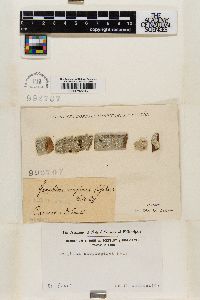
- Home
- Search
- Images
- Species Checklists
- US States: O-Z >
- US National Parks
- Central America
- South America
- US National Parks
- Southern Subpolar Region
|
|
|
|
Family: Graphidaceae
[Graphina subvirginalis (Nyl.) Müll.Arg., moreGraphis mosquitensis Tuck.] |
MB# 514007 TYPE. UNITED STATES. Florida, St. Augustine, C. Sprague s.n. (FH-TUCK #3396, lectotype designated in Kalb et al. 2004); Duval Co., Big Talbot Island State Park, ~ 0.7 mile S of northern boundary of park, coastal oak scrub, on branch of Lyonia ferruginea, 1987, W.R. Buck 15511 (NY, epitype designated in Tripp et al. 2010). Thallus crustose, thin, grayish-green; vegetative diaspores absent. Photobiont trentepohlioid alga. Ascomata lirellae, short, scattered, immersed to emergent, not branched; thalline margin thickened; exciple not striate, blackish; disk white pruinose. Hymenium hyaline; paraphyses apically ornamented. Ascospores hyaline, ellipsoid, muriform, 46–85 × 9–17 μm. Chemistry. K+ yellow turning red; norstictic acid. Substrate and Habitat. Corticolous on trees. Distribution. Southeastern North America; in North Carolina found in the Coastal Plain ecoregion. Literature Kalb, K., B. Staiger & J.A. Elix. (2004). A monograph of the lichen genus Diorygma – a first attempt. Symbolae Botanicae Upsaliensis 34(1): 133-181. Tripp, E.A., J.C. Lendemer & R.C. Harris (2010) Resolving the genus Graphina Müll. Arg. in North America: new species, new combinations, and treatments for Acanthothecis, Carbacanthographis, and Diorygma. Lichenologist 42(1): 55-71. Tuckerman, E. (1888) A synopsis of the North American lichens. Part. II. Comprising the Lecideacei, and (in part) the Graphidacei. New Bedford, Mass. 176 pp (original description as Graphis mosquitensis). |





































